Discover the potential downsides of 3D printing that you may not have considered. From high costs to environmental impact, learn how to address these challenges and optimize your 3D printing practices.
Table of Contents:
I. Introduction
- The expanding use of 3D printing technology
II. Cost-related Disadvantages
- High upfront costs for equipment and materials
- Maintenance and repair expenses
III. Quality-related Disadvantages
- Challenges in achieving high-quality prints
- Design limitations
IV. Safety and Environmental Disadvantages
- Health risks associated with certain materials and their emissions
- Environmental impact of 3D printing processes
V. How to Address Disadvantages and Optimize 3D Printing Practices
- Tips for reducing costs and improving quality
- Sustainability considerations
VI. Conclusion
- Conclusion and potential future developments in 3D printing technology
I. Introduction
As 3D printing continues to gain popularity, it’s important to understand the risks as well as the benefits. While 3D printing has revolutionized various industries, it also poses hidden risks that one must be aware of. One of the essential steps in optimizing 3D printing practices is by understanding the potential dangers that 3D printing presents.
II. Cost-related Disadvantages
One of the significant disadvantages of 3D printing is the high upfront costs for equipment and materials, including the printer, printing materials, software, and peripherals. Depending on the printer’s size and quality, the upfront cost of purchasing 3D printing equipment can range from $200 to $200,000. This upfront cost can be a significant barrier to entry for individuals or small businesses who want to enter the 3D printing space.
Moreover, the costs don’t end with the initial purchase of the 3D printer. Ongoing expenses can add up over time. The printing materials used in the 3D printing process can be costly, and the cost varies depending on the quality of the filament used. Another significant cost factor is maintenance and repair expenses. As with any machinery, 3D printers require maintenance and repairs to keep them functioning correctly.
III. Quality-related Disadvantages
Challenges in achieving high-quality prints are one of the major disadvantages of 3D printing. The print quality is determined by multiple factors, including the printer’s precision, the quality of the printing materials, and the printer’s ability to maintain the temperature. Achieving high-quality and detailed prints can be a daunting task, which can make the production process time-consuming and costly.
Design limitations are another significant disadvantage of 3D printing. Although 3D printing has opened many new possibilities in the design industry, there are still some limitations. Design constraints are primarily associated with the type of materials used and the 3D printer’s size and printing capabilities.
IV. Safety and Environmental Disadvantages
Another potential disadvantage of 3D printing is its impact on health and the environment. Various materials used in 3D printing have been identified as potential health risks. The fumes generated during the printing process and the emissions from certain materials can lead to respiratory issues and other health hazards.
The environmental impact of 3D printing is also a concern. Most 3D printers work by melting plastic filaments, leading to greenhouse gas emissions that contribute to global warming. Disposing of used materials can also pose environmental problems because not all materials used are biodegradable.
V. How to Address Disadvantages and Optimize 3D Printing Practices
There are methods and techniques to address these challenges while still taking advantage of 3D printing. Below are a few tips:
- Cost-saving measures:
- Optimize your design and printing processes to reduce the amount of material used.
- Consider purchasing refurbished 3D printers or reusing 3D printer parts instead of buying new parts.
- Use open-source software instead of proprietary software to save on licensing fees.
- Quality-optimizing measures:
- Experiment with different types of materials to find the one that offers the best quality prints.
- Calibrate the 3D printer to ensure accuracy and precision in the printing process.
- Adjust the printing temperature and speed to achieve better quality prints.
- Safety and environmental measures:
- Use 3D printers in a well-ventilated area to minimize exposure to fumes.
- Choose 3D printing materials that are biodegradable or recyclable to minimize the impact on the environment.
- Evaluate the materials used in the printing process to identify potential health hazards.
VI. Conclusion
In conclusion, 3D printing technology offers a wide range of possibilities but also poses various challenges that must be addressed. High costs, quality and design constraints, and environmental and safety concerns are some of the major disadvantages of 3D printing. However, by implementing cost-saving measures, optimizing quality, and taking safety and environmental precautions, individuals and businesses can still take advantage of 3D printing while minimizing the risks. As 3D printing technology continues to evolve, it’s essential to continue to evaluate its impact and explore new ways to optimize its potential.
Furthermore, advancements in technology are providing new methods to address the limitations of 3D printing. Some of these new technologies include 4D printing, which involves printing objects that can change shape over time or in response to specific stimuli. This technology has the potential to revolutionize various industries, such as healthcare and aerospace.
In conclusion, the potential downsides of 3D printing should not be ignored. However, by taking the necessary precautions and implementing various methods to address these challenges, we can continue to take advantage of the many benefits that 3D printing offers. From creating unique artwork to manufacturing complex parts, 3D printing has opened new possibilities and has the potential to revolutionize various industries. As such, it’s essential to stay updated on 3D printing technology and its impact to make informed decisions to optimize its potential.




